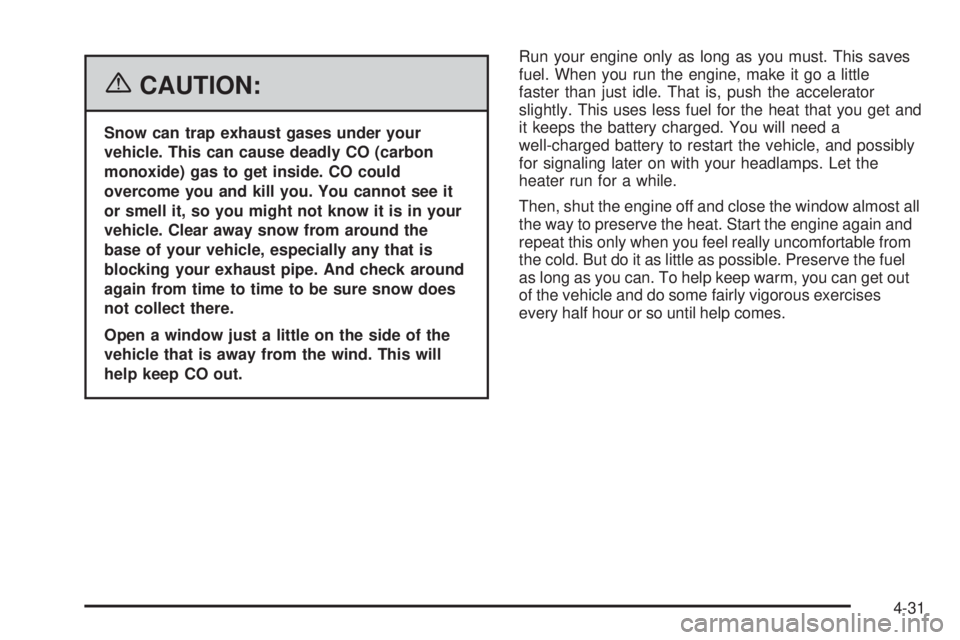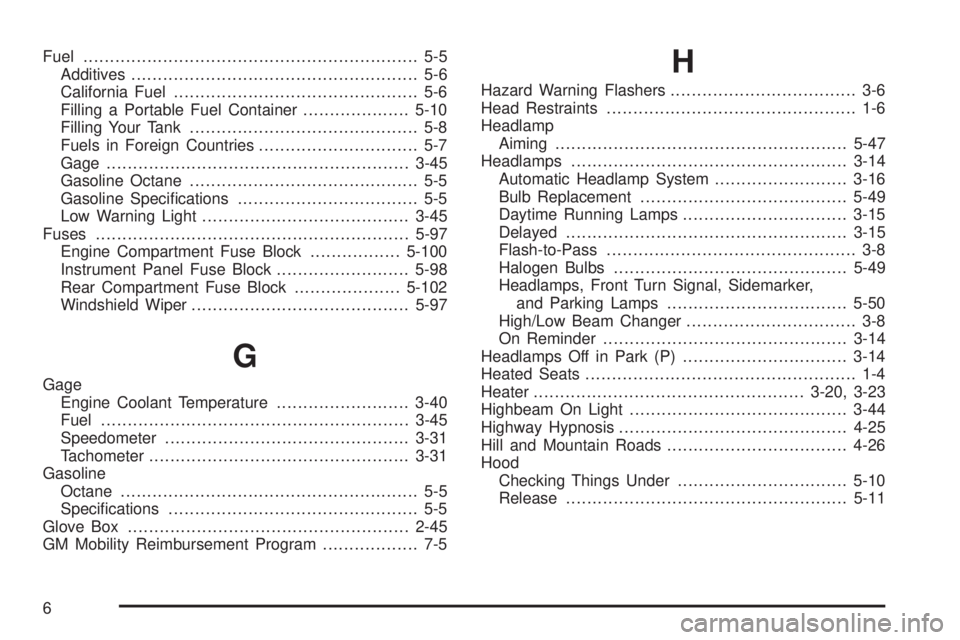check engine light PONTIAC G6 2006 User Guide
[x] Cancel search | Manufacturer: PONTIAC, Model Year: 2006, Model line: G6, Model: PONTIAC G6 2006Pages: 416, PDF Size: 2.66 MB
Page 251 of 416

{CAUTION:
Snow can trap exhaust gases under your
vehicle. This can cause deadly CO (carbon
monoxide) gas to get inside. CO could
overcome you and kill you. You cannot see it
or smell it, so you might not know it is in your
vehicle. Clear away snow from around the
base of your vehicle, especially any that is
blocking your exhaust pipe. And check around
again from time to time to be sure snow does
not collect there.
Open a window just a little on the side of the
vehicle that is away from the wind. This will
help keep CO out.Run your engine only as long as you must. This saves
fuel. When you run the engine, make it go a little
faster than just idle. That is, push the accelerator
slightly. This uses less fuel for the heat that you get and
it keeps the battery charged. You will need a
well-charged battery to restart the vehicle, and possibly
for signaling later on with your headlamps. Let the
heater run for a while.
Then, shut the engine off and close the window almost all
the way to preserve the heat. Start the engine again and
repeat this only when you feel really uncomfortable from
the cold. But do it as little as possible. Preserve the fuel
as long as you can. To help keep warm, you can get out
of the vehicle and do some fairly vigorous exercises
every half hour or so until help comes.
4-31
Page 297 of 416

Checking Coolant
The engine coolant surge tank is located in the rear of
the engine compartment. SeeEngine Compartment
Overview on page 5-12for more information on location.
{CAUTION:
Turning the surge tank pressure cap when the
engine and radiator are hot can allow steam
and scalding liquids to blow out and burn you
badly. Never turn the surge tank pressure
cap — even a little — when the engine and
radiator are hot.
The vehicle must be on a level surface. When your
engine is cold, the coolant level should be at the
FULL COLD mark or slightly higher.
If the LOW COOLANT message is displayed in the
Driver Information Center (DIC), it means you are low
on engine coolant. Have the system serviced by a
technician as soon as possible. SeeDIC Warnings
and Messages on page 3-48for more information.
5-29
Page 405 of 416

Capacities and Speci�cations..........................5-105
Carbon Monoxide...................2-14, 2-37, 4-27, 4-40
Care of
Safety Belts................................................5-91
Your CD and DVD Player.............................3-88
Your CDs and DVDs....................................3-88
Center Console Storage Area...........................2-45
Center High-Mounted Stoplamp (CHMSL)...........5-51
Chains, Tire...................................................5-73
Charging System Light....................................3-36
Check
Engine Light...............................................3-40
Checking Things Under the Hood......................5-10
Chemical Paint Spotting...................................5-94
Child Restraints
Child Restraint Systems...............................1-36
Infants and Young Children...........................1-33
Lower Anchors and Tethers for Children..........1-41
Older Children.............................................1-30
Securing a Child Restraint in a Rear Seat
Position..................................................1-49
Securing a Child Restraint in the Right Front
Seat Position...........................................1-52
Where to Put the Restraint...........................1-39
Cleaning
Aluminum Wheels........................................5-93
Exterior Lamps/Lenses.................................5-91
Fabric/Carpet..............................................5-89Cleaning (cont.)
Finish Care.................................................5-92
Inside of Your Vehicle..................................5-88
Instrument Panel, Vinyl, and Other Plastic
Surfaces.................................................5-90
Leather......................................................5-90
Tires..........................................................5-93
Underbody Maintenance...............................5-94
Washing Your Vehicle...................................5-91
Weatherstrips..............................................5-91
Windshield and Wiper Blades........................5-92
Climate Control System...................................3-20
Automatic...................................................3-23
Outlet Adjustment........................................3-28
Clutch, Hydraulic.............................................5-26
Comfort Guides, Rear Safety Belt.....................1-27
Compact Spare Tire........................................5-86
Content Theft-Deterrent....................................2-19
Control of a Vehicle.......................................... 4-5
Convenience Net............................................2-46
Coolant
Engine Temperature Gage............................3-40
Heater, Engine............................................2-27
Surge Tank Pressure Cap.............................5-30
Cooling System..............................................5-32
Courtesy Lamps.............................................3-17
Cruise Control................................................3-10
Cruise Control Light........................................3-44
3
Page 407 of 416

E
Easy Entry Seat............................................... 1-6
Electrical System
Add-On Equipment......................................5-97
Engine Compartment Fuse Block.................5-100
Fuses........................................................5-97
Instrument Panel Fuse Block.........................5-98
Power Windows and Other Power Options......5-97
Rear Compartment Fuse Block....................5-102
Windshield Wiper Fuses...............................5-97
Engine
Air Cleaner/Filter.........................................5-22
Battery.......................................................5-42
Check and Service Engine Soon Light............3-40
Coolant......................................................5-27
Coolant Heater............................................2-27
Coolant Temperature Gage...........................3-40
Engine Compartment Overview......................5-12
Exhaust.....................................................2-37
Oil .............................................................5-17
Oil Life System...........................................5-20
Overheated Protection Operating Mode...........5-32
Overheating................................................5-30
Starting......................................................2-24Enhanced Traction System (ETS)......................4-11
Active Light................................................3-39
Warning Light.............................................3-38
Entry/Exit Lighting...........................................3-18
Event Data Recorders (EDR)............................. 7-9
Extender, Safety Belt.......................................1-29
F
Filter
Engine Air Cleaner......................................5-22
Finish Damage...............................................5-94
Fixed Mast Antenna........................................3-88
Flash-to-Pass................................................... 3-8
Flat Tire........................................................5-74
Flat Tire, Changing.........................................5-74
Flat Tire, Storing.............................................5-83
Fluid
Automatic Transaxle.............................5-23, 5-24
Manual Transaxle........................................5-26
Power Steering...........................................5-37
Windshield Washer......................................5-38
Fog Lamps....................................................3-17
5
Page 408 of 416

Fuel............................................................... 5-5
Additives...................................................... 5-6
California Fuel.............................................. 5-6
Filling a Portable Fuel Container....................5-10
Filling Your Tank........................................... 5-8
Fuels in Foreign Countries.............................. 5-7
Gage.........................................................3-45
Gasoline Octane........................................... 5-5
Gasoline Speci�cations.................................. 5-5
Low Warning Light.......................................3-45
Fuses...........................................................5-97
Engine Compartment Fuse Block.................5-100
Instrument Panel Fuse Block.........................5-98
Rear Compartment Fuse Block....................5-102
Windshield Wiper.........................................5-97
G
Gage
Engine Coolant Temperature.........................3-40
Fuel..........................................................3-45
Speedometer..............................................3-31
Tachometer.................................................3-31
Gasoline
Octane........................................................ 5-5
Speci�cations............................................... 5-5
Glove Box.....................................................2-45
GM Mobility Reimbursement Program.................. 7-5
H
Hazard Warning Flashers................................... 3-6
Head Restraints............................................... 1-6
Headlamp
Aiming.......................................................5-47
Headlamps....................................................3-14
Automatic Headlamp System.........................3-16
Bulb Replacement.......................................5-49
Daytime Running Lamps...............................3-15
Delayed.....................................................3-15
Flash-to-Pass............................................... 3-8
Halogen Bulbs............................................5-49
Headlamps, Front Turn Signal, Sidemarker,
and Parking Lamps..................................5-50
High/Low Beam Changer................................ 3-8
On Reminder..............................................3-14
Headlamps Off in Park (P)...............................3-14
Heated Seats................................................... 1-4
Heater...................................................3-20, 3-23
Highbeam On Light.........................................3-44
Highway Hypnosis...........................................4-25
Hill and Mountain Roads..................................4-26
Hood
Checking Things Under................................5-10
Release.....................................................5-11
6
Page 411 of 416

Mirrors
Automatic Dimming Rearview
with Compass..........................................2-41
Automatic Dimming Rearview with OnStar
®
and Compass..........................................2-39
Manual Rearview Mirror................................2-39
Manual Rearview Mirror with OnStar
®.............2-39
Outside Convex Mirror.................................2-43
Outside Power Mirrors..................................2-43
MyGMLink.com................................................ 7-3
N
New Vehicle Break-In......................................2-22
Normal Maintenance Replacement Parts............6-13
O
Odometer......................................................3-31
Odometer, Trip...............................................3-31
Off-Road Recovery..........................................4-15
Oil
Engine.......................................................5-17
Pressure Light.............................................3-43
Oil, Engine Oil Life System..............................5-20
Older Children, Restraints................................1-30
Online Owner Center........................................ 7-3OnStar
®System, see OnStar®Manual...............2-44
Other Warning Devices...................................... 3-6
Outlet Adjustment............................................3-28
Outside
Convex Mirror.............................................2-43
Power Mirrors.............................................2-43
Overhead Console Reading Lamps....................3-18
Overheated Engine Protection
Operating Mode..........................................5-32
Owner Checks and Services.............................. 6-8
Owners, Canadian............................................... ii
P
Park (P)
Shifting Into................................................2-34
Shifting Out of............................................2-36
Park (P) Headlamps Off in Park (P)..................3-14
Parking
Brake........................................................2-33
Over Things That Burn.................................2-37
Parking Your Vehicle.......................................2-36
Passenger Airbag Status Indicator.....................3-34
Passenger Sensing System..............................1-65
Passing.........................................................4-16
PASS-Key
®III+..............................................2-20
PASS-Key®III+ Operation................................2-21
9